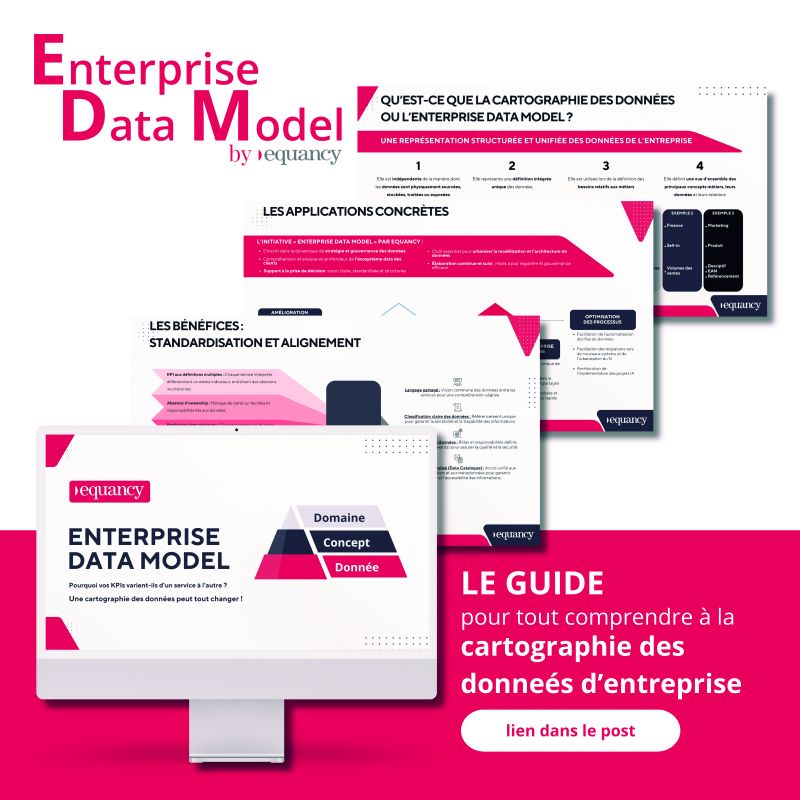Trend 2022: Data-driven marketing is the new philosopher's stone.
Of course, there is the sale of products in the metaverse, the purchase of NFT in cryptocurrency, the boom in video-commerce, the promise of DtoC in the face of the urgent need to acquire a 1st party database... However, if we had to keep only one, if we had to pronounce on THE trend of 2022, it is certainly "data-driven marketing" that would come to the top.
Nothing new under the sun you might say. But the scale and acceleration of the subject is taking on a dimension that will transform all marketing departments, all data departments and all technological departments in 2022.
The proof is in the pudding.
- In 5 years, the evolution of investments in big data by distribution players will be multiplied by 3.5* (Mordor Intelligence, 2021).
- Personalisation will generate a 50% reduction in acquisition costs* (McKinsey Study).
- Systematic use of data will increase e-commerce revenues by 15%* (Equancy's Client Benchmark)
- Companies that deploy personalised bounce-back communications will see a 10% increase in revenue* (McKinsey Study)
Who can beat that? In the face of this daily evidence of new and multiple data use cases that generate incremental revenue, the question is no longer, "Is this a major trend?", but "How can we accelerate data-driven marketing?", "How can we reap the benefits of data as quickly and profitably as possible?
A 2022 overview of the "data-benefits" of 7 marketing activities
From trend detection to data monetisation, product innovation or real-time promotion, every marketing activity will be "enhanced" by data. Like a new philosopher's stone, data-driven marketing transforms marketing to increase its speed, efficiency and profitability.
Activity 1: Global and instantaneous trend detection thanks to AI
With 2,900 health or beauty companies created since 1 January 2020 (Source Crunchbase), how can you stay sharp in your market? How to avoid missing the new diagnostic technology that will revolutionise beauty? How to be the first to detect the next unicorn to be incubated? The solution: automatic, global, qualified and instantaneous monitoring of all startups on the subject. Thanks to AI and NLP (Natural Language Processing), it is now possible to automatically source, classify and bring together players in new diagnostic technologies worldwide. From an initial corpus of players and keywords, this solution provides an instantaneous and global view of the 3,000 or so players who innovate and develop new diagnostic technologies in the beauty and health sectors every year. This saves a huge amount of time on business intelligence and an automatic alerting system that allows management committees and financial partners to detect, by area, the rising technologies that are likely to disrupt a market.
Activity 2: Product innovation or how image analysis selects the winning packaging
Product marketing is less of a data generator and consumer, more used to insights from consumer research than to data analysis, and has been slower than its counterpart, customer marketing, to taste the benefits of data. However, its contributions are no less strategic. How to choose the right packaging elements to increase the chances of success of a new product? Thanks to image analysis technologies, an algorithm now identifies the types and elements of packaging that will be most successful. Today, this type of solution makes it possible to estimate and predict - more reliably than consumer research - the chances of success of a product at its launch according to its packaging.
Activity n°3: sales forecasting or the delivery of the right volume of new products according to... past sales
In the era of fast fashion, the costs of restocking a shop due to a stock shortage or taking back unsold products due to poor forecasts have a heavy impact on the company's income statement. However, many players in the retail sector continue to supply each shop with the same quantity of products in an indiscriminate and equal manner, according to the established rule: "Quantity produced divided by the number of shops = number of products/store". But when one shop sells 10 of the same products in 1 month, the other will sell 2 in 3 months. To compensate for this costly difference in logistical costs, a visual similarity algorithm between old and new collections will provide access to the sales history of similar models for each shop. Thus, in the whirlwind of new products produced, it will identify and predict, by shop, the products that are most likely to be sold out, in which colour, in which size and over which months!
The result is huge financial gains and the assurance that customers will no longer be dissatisfied with a stockout.
Activity n°4: Real-time promotion, a massive conversion weapon
When it comes to activating a customer, the moment now prevails over the segment. Indeed, if data is used to detect the intention to buy, this takes precedence over the status of the customer. Whether a customer is a first-time buyer or a repeat buyer, young or old, single or multi-product, online or off-line buyer, his or her membership of a particular customer segment is "overridden" by his or her desire to buy a particular product at a particular time. In this respect, triggering the right promotion in real time is a massive conversion weapon. Here, the new scoring models based on the historical behaviour of buyers when faced with a promotion make it possible, depending on the customer's promo-sensitivity, to vary the amount of the promotion (5% or 15%), to push the format that is most likely to seduce them (percentage, monetary gain, "buy 2, get the 3rd one 50% off" formula, etc.) and to identify the best time to offer a promotion. The digitisation of exchanges and interactions today facilitates this real-time adjustment at each stage of the customer journey with the major benefit of not "offering" customers who would buy without a promotion a useless discount!
Activity 5: Contextualised product recommendation, stronger than Amazon!
There is a recommendation engine and a recommendation engine. Everyone knows the principle "people who bought this book also bought that book". But today, this simplistic textbook example that requires little intelligence is no longer sufficient. To increase the relevance of the recommendation, what makes the difference is contextualisation. Thus, thanks to the consolidation of customer journey and transaction data, the product pushed to such and such a customer will not be the same if his basket previously contained 1 product or 3, if he has browsed on such and such pages of the site, if the brand wishes to remove its best sellers from the recommendations or to put forward its "loyalty products" or if the customer has shown the sales assistant the image of a competing product. And above all, to find the right combination and the right weighting between the different dimensions. The result is a much higher performance of the contextualised recommendation algorithm and therefore better conversion rates on CRM campaigns. And for the salesperson or telephonist, confidence in the product prescription tools which makes his or her personalised customer support more reliable and ultimately boosts up-selling and cross-selling.
Activity n°6: anticipating churn, when the customer is ready...
Five years ago, most churn scores were based on 3-4 criteria (a drop in frequency, recency and amount, etc.) and made customers likely to churn eligible for the "To be reactivated" segment, pending the quarterly anti-churn campaign. Today, more than 60 combined criteria (CRM activity, socio-demographic profile, browsing data, customer satisfaction and feedback, etc.) can be used to refine a churn score and trigger a reactivation campaign for the individual and at the precise date when the customer should have purchased. To do this, it is sufficient to move from descriptive analysis to predictive analysis. The aim is to train the algorithm on churners to identify the characteristics and paths that led them to abandon the brand. Then, it is enough to identify the customers who are not (yet) churners and who have the same characteristics and repeat the same paths as the churners in order to avoid their future attrition. And this is where data-driven marketing reaches its peak, because with this predictive score, anti-churn activations are triggered even before the customer runs out of steam or shows signs of sagging consumption, or even knows himself that he might not buy this brand in the next 6 months!
Activity 7: Monetizing data is a new source of revenue for retailers
Not only does data generate additional revenue and reduce the costs of marketing activities, but it also becomes a source of revenue in its own right, capable of self-financing all the developments and purchases of solutions that are made in its name. Thus Retail Media. Today, a retailer such as Carrefour or Sephora markets the astronomical volume and precision of the data at its disposal for the greater benefit of the brands it distributes. This is a valuable asset for brands which, thanks to this detailed knowledge of customers (household typology, purchasing habits, brand loyalty rates, promotional sensitivity, favourite websites, etc.), can quickly identify, with certainty: direct competitors, market shares gained on other products or brands, variations in customer base, sites and media frequented by their customers, virtuous loyalty paths, or audiences with high acquisition conversion rates.
So how do we accelerate data-driven marketing in 2022?
Answer in 4 steps.
- Assess the company's data maturity.
- Estimate the pockets of value at each stage of the customer journey if the data were more voluminous and/or better exploited.
- Identify the use cases to be put in place to capture the most promising pockets of value.
- Define the target Adtech and Martech ecosystem that will be able to execute the defined use cases.
And to accelerate..., the fastest way is to start at the beginning of the year!
Bertrand Destailleur
Associate Customer Experience




